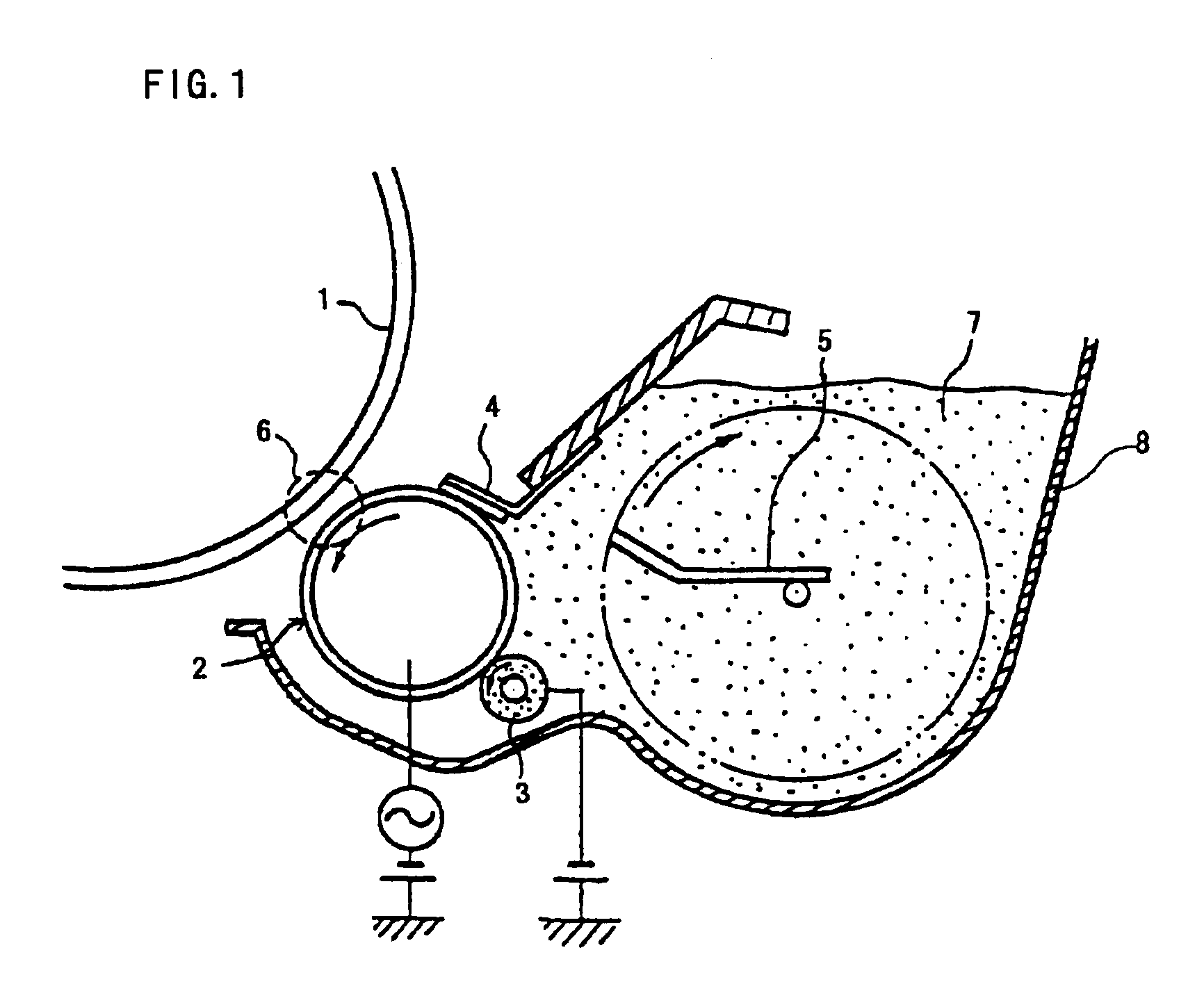Dry toner for developing electrostatic images
a toner and electrostatic technology, applied in the field of toner for developing electrostatic images, can solve the problems of void phenomenon in the toner image, low environmental fluctuation resistance, image adherence to the mat or becoming sticky, etc., and achieves high manufacturability and high manufacturability.
- Summary
- Abstract
- Description
- Claims
- Application Information
AI Technical Summary
Benefits of technology
Problems solved by technology
Method used
Image
Examples
example 1
Preparation of Copolymer Resin
In a separable flask equipped with a stirrer, a thermometer, a N2 feed port and a condenser, 300 g of a low molecular weight bisphenol A / epichlorohydrin epoxy resin (EPOMIK R-140P, manufactured by Mitsui Chemicals Inc., number-average molecular weight: about 360), 150 g of a high molecular weight bisphenol A / epichlorohydrin epoxy resin (EPOMIK R-309, manufactured by Mitsui Chemicals Inc., number-average molecular weight: about 2900), 230 g of a diglycidylate of a bisphenol A type propylene oxide adduct (compound of the above formula (1), in which (n+m) is about 2.1), 240 g of bisphenol A, 90 g of p-cumylphenol, 50 g of a low molecular weight polyester resin (a condensate of bisphenol A type propylene oxide adduct and phathalic anhydride, number-average molecular weight: 1500) and 200 g of xylene were charged. After the contents in the flask had been heated to 70-100° C. in a nitrogen atmosphere, 0.183 g of lithium chloride was added thereto. The mixture...
example 2
Preparation of Toners
Yellow, magenta, cyan and black toners having an average particle size of 7 μm were prepared from the following ingredients in the same manner as that in Example 1. Copolymer Resin 2 was synthesized in the same manner as that for the preparation Copolymer Resin 1 in Example 1 except that the weight ratio of the epoxy resin of the polyol resin moiety to the polyester resin moiety was changed to 95:5. Physical properties of the Copolymer Resin 2 were summarized in Table 1.
Yellow toner:Copolymer Resin 2100 partsYellow pigment 6 parts(TONER YELLOW HG, manufactured byClarient Corp.)E-84, manufactured by Orient Chemical 2 partsMagenta toner:Copolymer Resin 2100 partsRed pigment 5 parts(LIONOGEN MAGENTA R, manufactured byToyo Ink Mfg. Co., Ltd.)E-84, manufactured by Orient Chemical 2 partsCyan toner:Resin 2100 partsBlue pigment 4 parts(LIONOL BLUE FG-7351, manufactured byToyo Ink Mfg. Co., Ltd.)E-84, manufactured by Orient Chemical 2 partsBlack toner:Resin 2100 partsBl...
example 3
Coplymer Resin 3 was prepared in the same manner as in Example 1 except that trimellitic acid was used in place of phthalic anhydride. Physical properties of the thus obtained Copolymer Resin 3 are summarized in Table 1. Then, yellow, magenta, cyan and black toners (average particle size: 7 μm) were prepared in the same manner as in Example 1 except that Copolymer Resin 3 was used in place of Copolymer Resin 1.
0.5 Part of hydrophobic silica (R972 manufactured by Nippon Aerosil Co.) and 0.3 part of hydrophobic titania (STT-30A manufactured by Titan Kogyo K.K.) as external additives were mixed with 100 parts of each of the thus obtained toners. 3 Parts of each toner was mixed with 97 parts of a carrier obtained by coating spherical ferrite particles having an average diameter of 50 μm with a silicon resin, thereby obtaining two-component developers of yellow, magenta, cyan and black. The developers were charged in a commercially available electrophotographic copying machine (IMAGIO MF...
PUM
| Property | Measurement | Unit |
|---|---|---|
| Temperature | aaaaa | aaaaa |
| Temperature | aaaaa | aaaaa |
| Percent by mass | aaaaa | aaaaa |
Abstract
Description
Claims
Application Information
 Login to View More
Login to View More - R&D
- Intellectual Property
- Life Sciences
- Materials
- Tech Scout
- Unparalleled Data Quality
- Higher Quality Content
- 60% Fewer Hallucinations
Browse by: Latest US Patents, China's latest patents, Technical Efficacy Thesaurus, Application Domain, Technology Topic, Popular Technical Reports.
© 2025 PatSnap. All rights reserved.Legal|Privacy policy|Modern Slavery Act Transparency Statement|Sitemap|About US| Contact US: help@patsnap.com


